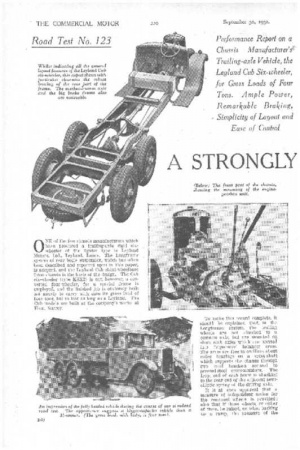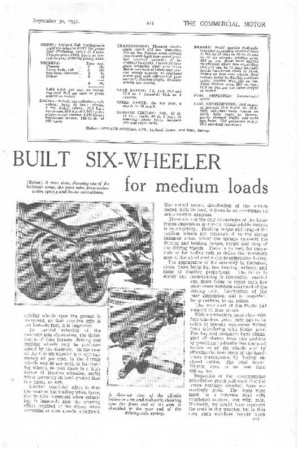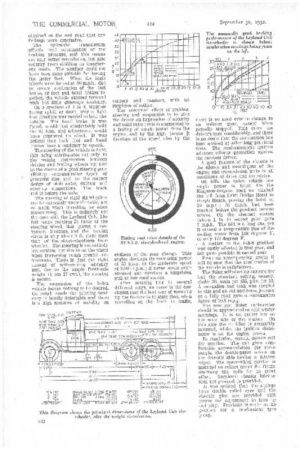A STRONGLY
Page 58

Page 59

Page 60

If you've noticed an error in this article please click here to report it so we can fix it.
BUILT SIX-WHEELER for medium loads
Performance Report on a Chassis Manufacturer's Trailing,axle Vehicle, the Leyland Cub Six.wheeler, for Gross Loads of Four Tons. Ample Power, Remarkable Braking, Simplicity of Layout and Ease of Control
0 NE of the few chassis manufacturers which have produced a trailing-axle rigid sixwheeler of the lighter type is Leyland Motors, Ltd., Leyland, Lancs. The Longframe system of rear bogie suspension, which has often been described and reported upon in this paper, Is adopted, and the Leyland Cub short-wheelbase 2-ton chassis is the basis of the design. The Cub six-wheeler (type KSX2) is not, however, a converted four-wheeler, for a special frame is employed, and the finished job is obviously built not merely to carry with ease its gross load of four tons, but to last as long as a Leyland. The Cub models are built at the company's works at Ham, Surrey.
To make this record complete, it should be explained that, in the Longframel system, the trailing wheels are not attached to a common axle, but are mounted on short stub axles which are pressed into forged-steel balancer arms. The arms are free to oscillate about roller hearings on a cross-shaft which supports the chassis through two steel brackets secured to pressed-steel cross-members. The front end of each beam is shackled to the rear end of the adjacent semielliptic spring of the driving axle.
It is at once apparent that a measure of independent action for the rearmost wheels is provided ; also that if those wheels, or either of them, be raised, as when backing up a ramp, the pressure of the driving wheels upon the ground is increased, so that tractive grip is not last—in fact, it is improved.
By careful selection of the balancer-arm dimensions, the distribution of load between driving and trailing wheels may be predetermined by the designer. In the case of the Cub six-wheeler it is approximately 60 per cent. to the driving wheels and 40 per cent. to the trailing wheels, so that there is a high factor of tractive adhesion, useful when operating on level ground that Is slippery or soft.
Another beneficial effect is that the wear on the trailing-wheel tyres, due to side movement when cornering, is lessened ; also the steering effort required of the driver when cornering at slow speeds is reduced. The actual weight distribution of the vehicle tested, with its load, is given in an accompanying side-elevation diagram.
These are riot the only advantages of the Longframe suspension system ; a commendable feature is its simplicity. Braking torque and drag of the trailing wheels are transmitted to the strong balancer arms, whilst the springs transmit the driving and braking torque, thrust and drag of the driving wheels. There is no need for torque rods or for radius rods to define the movement arcs of the wheel centre due to suspension flexing.
The appearance of the assembly is, therefore, clean, there being but few hearing surfaces, and these of massive proportions. The frame is sturdy and cross-bracing is thoroughly carried out, there being no fewer than five stout cross-members rearward of the driving axle. Lubrication of the rear suspension unit is simplified, being confined to six points.
The rear part of the frame has support at four points.
With six-wheelers, more than with four-wheelers, great care has to be taken to prevent suspension flexing from interfering with brake gear. The Leyland designers have eliminated all chance from this problem by providing hydraulic foot-operated brakes on all six wheels, and by effecting the final stage of the handbrake transmission by flexibly enclosed cables. The total brakefriction area is no less than 630 sq. ins.
Inspection of the accompanying retardation graph will show that the brake readings obtained were exceedingly good. The tests were made on a concrete road with roughened surface, wet with rain. Normally, we would have repeated the tests in dry weather, but in this case such excellent results were
obtained on the wet road that our findings were conclusive.
The hydraulic transmission affords real equalization of the braking pressure, and this means not only better retardation, but also security from skidding on treacherous roads. The weather could not have been more suitable for testing the latter fact. When the bogie wheels were locked at 30 m.p.h., due to severe application of the foot brake, or foot and hand brakes together, the vehicle skidded forward with but little sideways tendency.
On a gradient of 1 in 8, whether facing uphill or down, only a light foot pressure was needed to hold the vehicle. The hand brake, it was found, would just comfortably hold the 61 tons, and adjustment would have improved its effect. It was noticed that both foot and hand brakes have a tendency to squeak.
The steering of the vehicle is light, this being attributable not only to the weight distribution between driving and trailing wheels but also to the choice of a good steering gear (Bishop cam-and-roller type) of generous size, and to the correct design of stub axles, swivels and steering connections. The track rod is before the axle.
The steering of rigid six-wheelers can be extremely uncomfortable, not so much when travelling as when manteuvring. This is definitely not the case with the Leyland Cub. The full range requires 2i turns of the steering wheel, this giving a 'convenient leverage, and the turning circle is only about 5 ft. more than that of the short-wheelbase fourwheeler. The steering is not entirely irreversible, but shocks on the wheel when traversing rough ground are moderate. There is just the right amount of self-centring tendency and, due to the ample front-axle weight (1 ton 17 cwt.), the steering is secure.
The suspension of the laden vehicle leaves nothing to be desired. On rough roads the pitching tendency is hardly detectable and there is a high measure of stability on
corners and cambers, with no suspicion of rolling.
The combined effect of braking, steering and suspension is to give the driver an impression of security and solid build ; this is augmented by a feeling of ample power from the engine, and by the high torque it develops at low speed, also by the easiness of the gear change. This engine develops its maximum power of 55 b.h.p. at the moderate speed of 2,000 r.p.m.; it never seems overstressed and develops a surprising pull at low road speeds.
After noticing this in several different ways, we came to the conclusion that the best way of summing up the feature is to state that, when travelling on the level in traffic, there is no need ever to change to an indirect gear, except when actually stopped. This eases the driver's task considerably, and there is no doubt that the carburation has been arrived at after long practical tests. The semi-automatic ignition advance affords protection against the careless driver.
A good feature of the chassis is the silence and smoothress of the engine and transmission units in all conditions of drive and over-drive.
On hills the laden vehicle has ample power in hand. On the Kingston-Reigate road we climbed the hill from Drift Bridge Hotel to Burgh Heath, passing the hotel at 20 m.p.h. • 31 m.p.h. had been reached before the gradient became severe. On the steepest section (about 1 in 8) second gear gave 7 m.p.h. The hill is a long one, yet it caused a temperature rise of the cooling water from 158 degrees F. to only 174 degrees F.
A restart on the 1-in-8 gradient was easily effected in first gear, and not quite possible in second gear.
From an accompanying graph it will be seen that the acceleration of the vehicle is satisfactory.
The Solex self-starting carburetter had the standard setting, namely, choke 30, main jet 135, pilot jet 55. A one-gallon test tank was coupled to this and an out-and-home journey on a hilly road gave a consumption figure of 10.8 m.p.g.
The new-type Solex carburetter should be appreciated on cold winter mornings. It is set rather low on the near side of the engine. On this side the oil filler is accessibly mounted, whilst the ignition distributor is on the engine crown.
In conclusion, certain details call for mention. The cab gives comfortable accommodation for three people, the double-panel screen on the driver's side having a Klaxon wiper. The spare-wheel carrier is mounted on rollers under the frame overhang and calls for no great effort. Tecalennit chassis lubrication, not grouped, is provided.
It was noticed that the springs have double rolled eyes and the shackle pins are provided with means for adjustment to take up end play. Provision is made on the gearbox for a mechanical tyre pump.






































































































